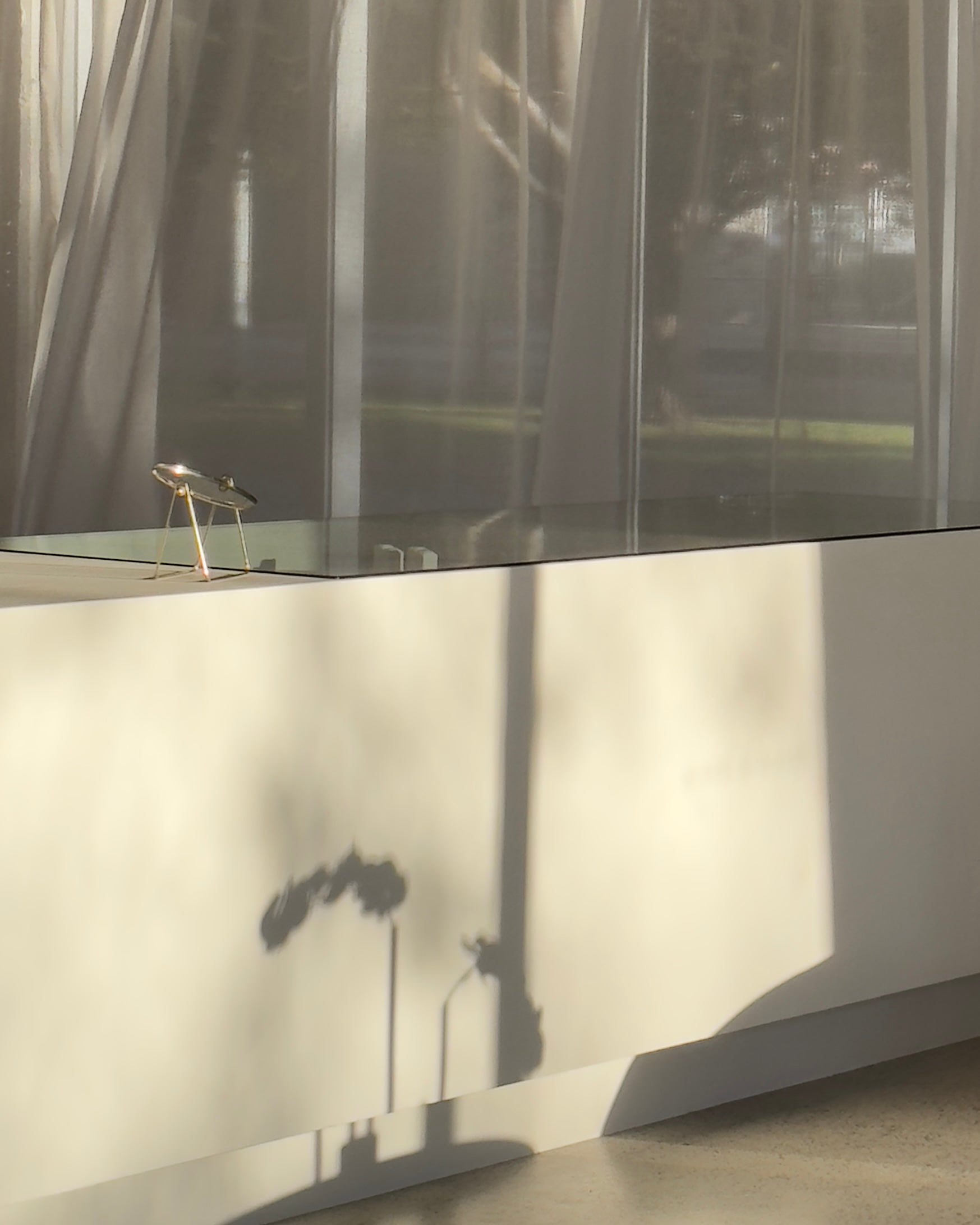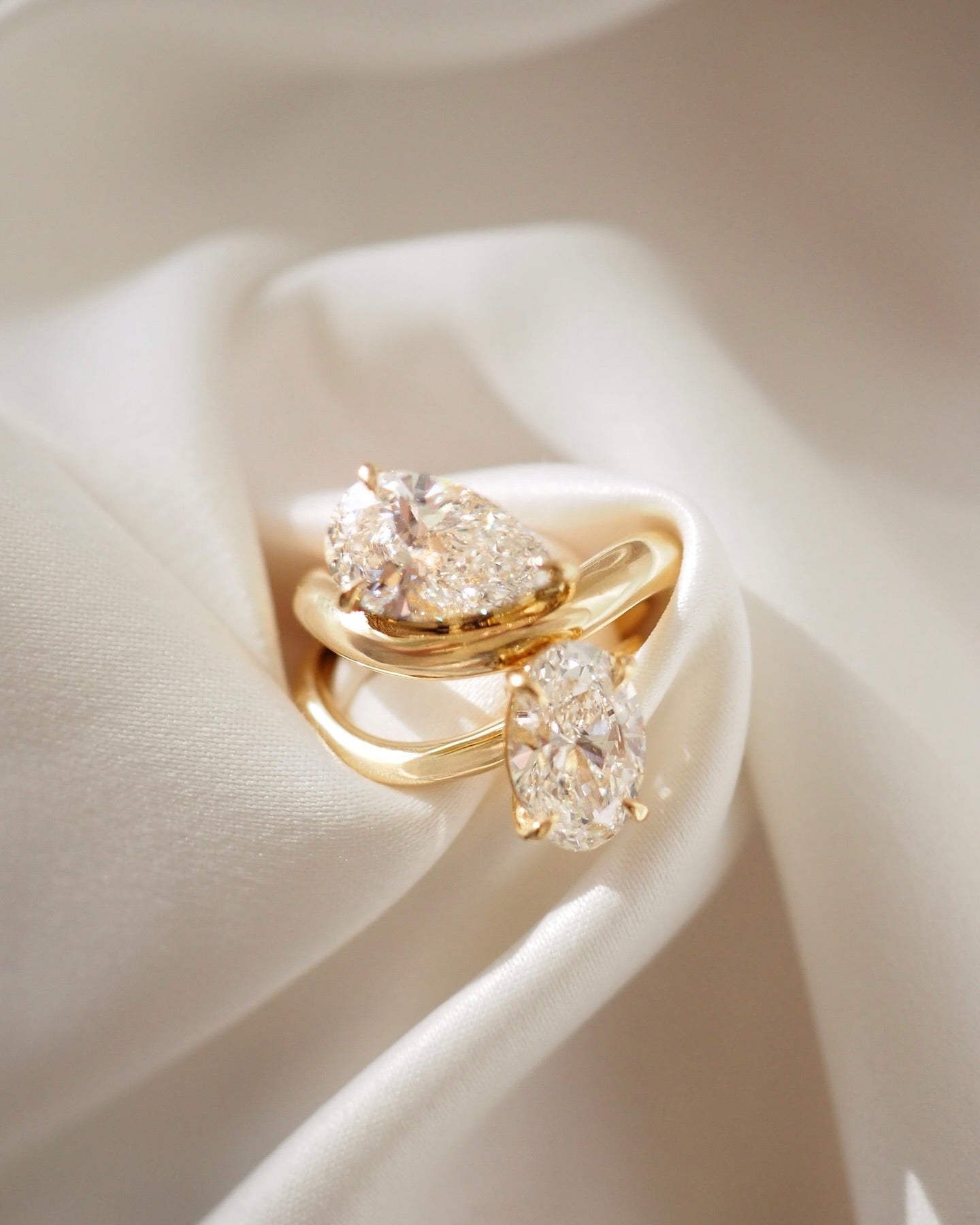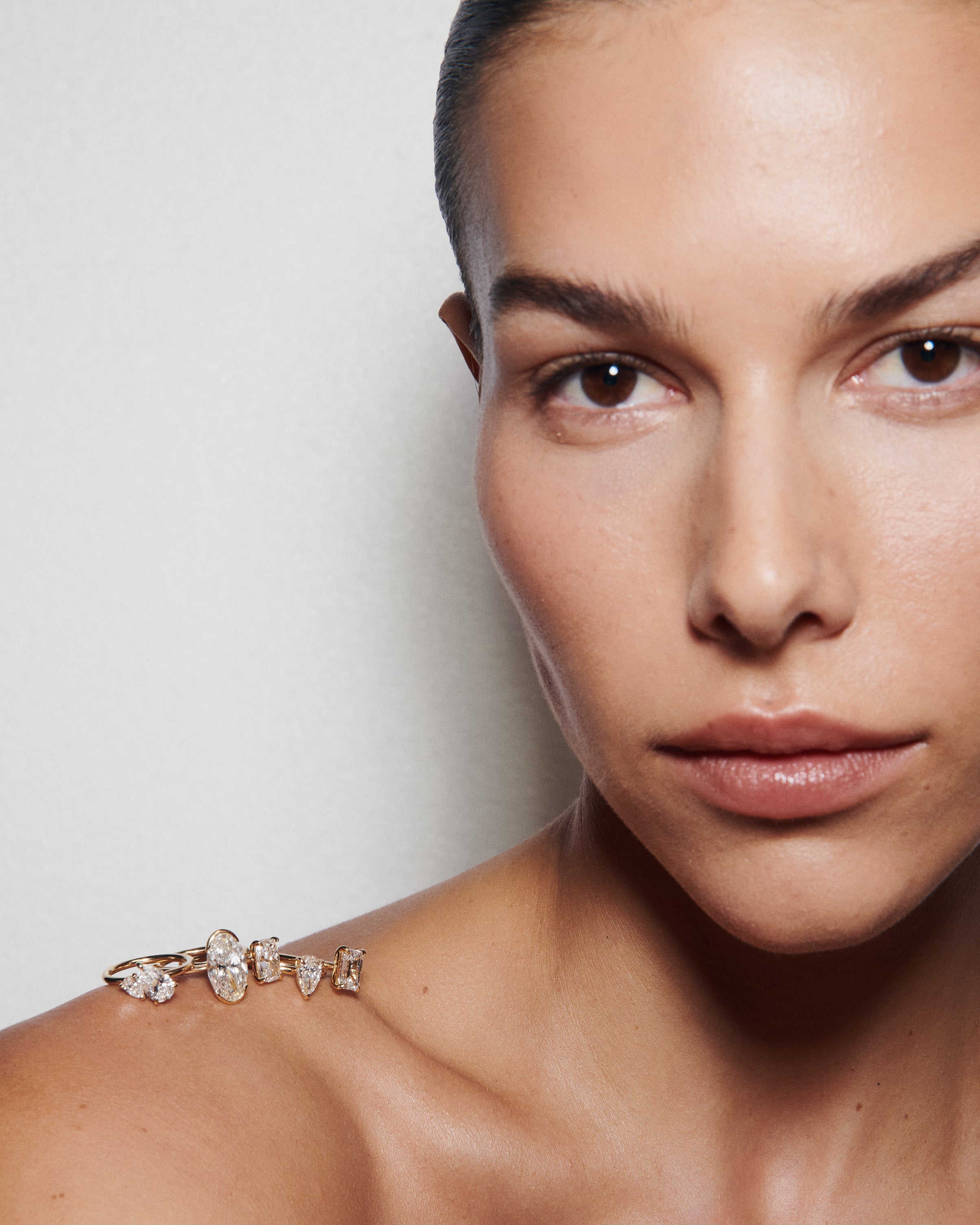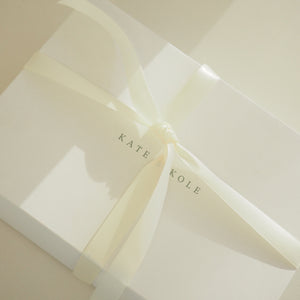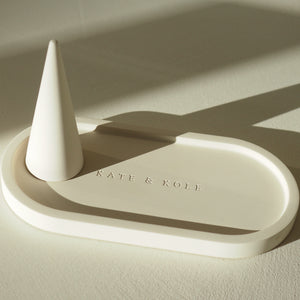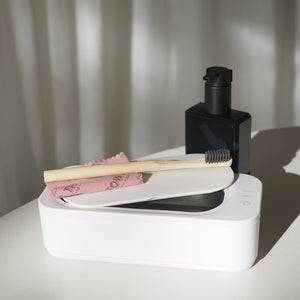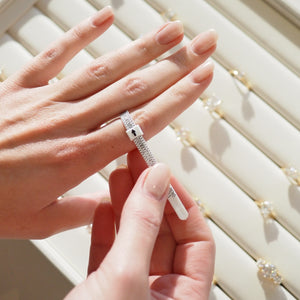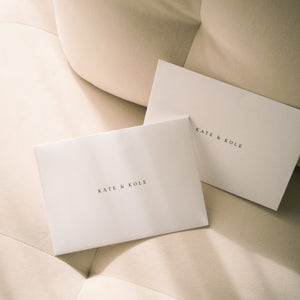Glossary
Glossary
Metals & Materials
Alloy
An alloy is a blend of metals created to improve durability, colour, or workability. For example, gold is often alloyed with silver, copper, or zinc to create different tones—yellow, white, or rose—and to strengthen it for everyday wear.
Carat (Gold Purity)
When referring to gold, carat measures purity, not weight. 24ct is pure gold, while 18ct is 75% gold mixed with alloy metals. At Kate & Kole, we work with 9ct and 18ct gold, choosing the best alloy for each design to balance beauty and strength.
Rhodium Plating
A thin layer of rhodium—a rare white metal—is often applied to white gold to give it a bright, reflective finish. Over time, this layer may wear and can be reapplied as part of ongoing jewellery care.
Recycled Gold
All of our gold is made from 100% recycled materials, refined to the same quality as newly mined gold but gentler on the planet. A core part of our sustainability practices.
Sterling Silver
Sterling silver is 92.5% pure silver and 7.5% alloy, typically copper. This alloy improves strength and makes the piece suitable for everyday wear while keeping its bright white finish.
Platinum
Platinum is a naturally white metal known for its density and durability. It’s heavier than gold and doesn’t require rhodium plating—but it’s also softer, which means it may develop a patina over time rather than staying mirror-bright.
Gold Tones (Yellow, Rose, White)
- Yellow Gold: Classic and warm. Created by alloying pure gold with silver and copper.
- Rose Gold: Romantic and blush-toned. Copper is added to gold for its signature hue.
- White Gold: Cool and contemporary. Created by alloying gold with white metals, then plated in rhodium for brightness.
Metal Hardness
Different metals and alloys have different hardness levels. For instance, platinum is dense but softer, while 14ct gold is harder than 18ct due to a higher alloy content. Hardness affects how jewellery wears over time and what designs are most suitable.
Stone Shapes
Round Brilliant
The most classic and popular diamond shape, known for its unmatched sparkle. With 58 facets, the round brilliant is designed to maximise light and fire—perfect for timeless solitaires and pavé settings.
Oval
An elongated version of the round brilliant, the oval shape creates a flattering, finger-lengthening effect. It offers similar brilliance to a round but with a softer, modern silhouette—one of our most loved shapes.
Emerald
Characterised by its step-cut facets and open, mirrored table, the emerald cut offers a clean, architectural look. It’s less about sparkle and more about clarity and refinement—understated luxury at its best.
Radiant
A hybrid between the brilliant and step cut, radiant stones combine sparkle with sharp edges. With clipped corners and plenty of fire, this shape suits modern settings beautifully.
Cushion
Soft and romantic, cushion-cut stones feature rounded corners and a pillow-like shape. They offer vintage charm and a gentle brilliance, perfect for lovers of timeless elegance.
Princess
Square in shape and brilliant in cut, the princess cut is sharp, modern, and full of sparkle. Best suited to protective settings (like a bezel or halo) due to its pointed corners.
Asscher
A square version of the emerald cut with deeper facets and a distinctive X pattern in the centre. Asscher cuts are bold, vintage-inspired, and ideal for those who love symmetry and depth.
Pear
Also known as teardrop, the pear shape combines a rounded end with a tapering point. It’s elegant, feminine, and versatile—especially when paired with a hidden halo or delicate claws.
Marquise
With its elongated body and pointed ends, the marquise shape feels regal and unique. It creates maximum visual size for carat weight and pairs beautifully with curved bands or double claw settings.
Heart
A rare and deeply symbolic shape, the heart-cut diamond is often chosen for bespoke or romantic designs. It requires precise symmetry to achieve its signature look and sparkle.
Diamonds & Gemstones
Carat (Diamond Weight)
When used in reference to diamonds and gemstones, carat is a unit of weight, not size. One carat equals 0.2 grams. While carat affects the visual impact of a stone, it’s just one of the 4Cs to consider when selecting a diamond.
Cut
Cut refers to how well a diamond or gemstone has been shaped and faceted—not just its shape (like round or oval), but the quality of the angles, proportions and polish. A well-cut stone will reflect light beautifully and appear more brilliant.
Colour
For diamonds, colour is graded on a scale from D (colourless) to Z (noticeably tinted). At Kate & Kole, we work with premium stones typically graded D–F, which appear icy white and luminous.
Clarity
Clarity refers to the presence (or absence) of internal marks (inclusions) or surface flaws (blemishes) in a diamond. Most are invisible to the naked eye. We favour stones graded VS (Very Slightly Included) or higher for a clean, bright finish.
Lab-Grown Diamonds
Lab-grown diamonds are chemically and optically identical to natural diamonds, but created in controlled environments rather than mined. They are more sustainable and traceable—our choice at Kate & Kole for all made-to-order pieces.
Natural Diamonds
Formed over billions of years beneath the Earth’s surface, natural diamonds are treasured for their rarity. At Kate & Kole, we work exclusively with lab-grown diamonds by default, but can source natural stones upon request.
Moissanite
Moissanite is a lab-created gemstone known for its brilliant sparkle and durability. While not a diamond, it’s a popular diamond alternative due to its clarity and lower price point. We do not offer Moissanite at Kate & Kole.
Cubic Zirconia
Cubic zirconia (CZ) is a man-made stone that looks like a diamond but is far less durable. At Kate & Kole, we use cubic zirconia only in our rental proposal rings—never in our fine jewellery collections.
Birthstones
Each month has an associated birthstone, often used to symbolise loved ones in personalised jewellery. Whether it’s sapphires for September or emeralds for May, these stones add meaning and story to your piece.
Fluorescence
Some diamonds glow under UV light due to natural properties. This is known as fluorescence. While often not visible in normal light, strong fluorescence can sometimes make a diamond look milky—something we carefully assess during selection.
Inclusions / Blemishes
Inclusions are internal features formed during a diamond’s creation, and blemishes are surface marks. These natural characteristics help gemologists grade clarity. We carefully inspect every stone to ensure beauty and quality.
SCS-007 Certified
This third-party certification ensures lab-grown diamonds meet the highest sustainability standards. It includes climate neutrality, ethical stewardship, and origin traceability—values that align with our own.
Ring Settings
Solitaire
A solitaire setting showcases a single centre stone—no side stones, no distractions. It’s timeless, elegant, and perfect for letting the diamond speak for itself. At Kate & Kole, our solitaire rings are carefully designed to highlight both stone and setting with intention.
Halo
A halo setting surrounds the centre stone with a circle of smaller diamonds, enhancing its sparkle and making the central stone appear larger. It’s a brilliant choice for added drama and dimension.
Hidden Halo
A modern twist on the halo, the hidden halo features a ring of small diamonds tucked beneath the centre stone, only visible from the side. It adds subtle sparkle and architectural interest—one of our most requested details.
Basket Setting
This style holds the centre stone in a low, secure ‘basket’ of metal prongs that cradle the gem from underneath. It allows more light into the stone while sitting slightly lower on the finger—perfect for everyday wear.
Bezel Setting
A sleek, modern style where the metal surrounds the stone completely or partially, holding it in place. A bezel setting offers security and a clean, contemporary finish—ideal for those with active lifestyles.
Cathedral Setting
Named for its graceful arches, the cathedral setting uses elevated shoulders to lift the stone above the band. It adds height and elegance, with a sculptural feel that draws the eye to the centrepiece.
Tension Setting
In this minimalist style, the stone appears suspended between the two ends of the band using pressure (tension). It’s striking and modern—but best suited for harder stones and occasional wear.
Claw / Prong Setting
Prongs or “claws” grip the stone at key points (typically 4 or 6), allowing maximum light to enter the diamond for brilliance. The most classic and popular setting style for engagement rings.
Pavé Setting
From the French word for “paved”, a pavé setting features tiny diamonds set closely together, often along the band, creating a glittering surface of light. Our pavé rings are handset with precision for durability and beauty.
Channel Setting
Small diamonds are nestled in a channel between two strips of metal—no prongs, just clean lines and seamless sparkle. Popular in wedding bands and stacking rings.
Flush Setting
Here, the stone is set directly into the band so the top of the stone is flush with the metal surface. It’s understated, secure, and great for everyday wear—especially for men’s or gender-neutral designs.
Double Band / Split Shank
This design features a band that splits into two as it approaches the centre stone, adding width, drama, or architectural detail. A signature feature in some of our more sculptural designs.
Toi et Moi
French for “You and Me”, this romantic setting features two stones side by side—often representing two souls or a shared journey. A modern heirloom with deep symbolism.
Design Features
Gallery (Ring)
The gallery is the space beneath the centre stone, often hidden from top view. At Kate & Kole, this is where our jewellers add thoughtful details—like a hidden halo, architectural shapes, or hand-drawn hearts—adding meaning and visual intrigue to the ring’s profile.
Shoulders
The shoulders are the sides of the band leading up to the centre stone. They can taper, split, hold pavé diamonds, or remain minimal. We design each pair of shoulders to balance structure and softness, ensuring the perfect frame for your chosen stone.
Band Width / Thickness
Band width refers to how wide the ring is across your finger; thickness refers to how deep the metal is from top to bottom. These proportions affect both comfort and visual weight. We often fine-tune them for each design to create balance, presence, and longevity.
Knife Edge
A knife edge band features a subtle ridge along the centre, creating a sculptural profile. It adds dimension without adding bulk—perfect for stacking or as a modern twist on a classic style.
Tapered Band
Tapering is when the band narrows as it approaches the stone. It can create a more delicate, refined look and allows the centre stone to visually ‘float’ with more prominence.
Stone Orientation (North/South vs East/West)
- North/South: Stone is set traditionally, pointing along the finger.
- East/West: The stone is rotated to sit horizontally. A contemporary setting choice that creates a bolder, more unique silhouette.
Milgrain
A decorative technique where tiny metal beads are added along the edge of a design. It adds a vintage feel and tactile texture—something we use sparingly for added romance.
Hand-Drawn Details
A Kate & Kole signature. Some of our rings feature engraved motifs—like hearts or initials—sketched by hand and laser engraved by our jewellers. A hidden message that makes your piece truly yours.
Personalisation
From birthstones to initials, we offer a range of personalisation options that turn your piece into a keepsake. Whether it’s a hidden engraving or a stone for every child, your story is always welcome here.
Engraving
Engraving is the art of inscribing letters, numbers, or motifs onto a jewellery surface. We offer both hand-drawn and classic fonts—popular for initials, dates, or private messages hidden inside a band.
Charm
A charm is a small decorative element that can be fixed or sliding, often added to necklaces or bracelets. Our charms are often symbolic—initials, hearts, or birthstones—and can grow with your story.
Component
A component is any individual element used to create your piece—such as the band, basket, or charm. Understanding components helps us repair, resize, or evolve your piece with precision and care.
Production & Jewellery Terms
CAD (Computer-Aided Design)
CAD is the digital design process we use to bring your jewellery to life before it’s made. Every bespoke and made-to-order piece starts here—mapped out in exact detail so we can show you renders, make edits, and ensure a perfect fit before it’s cast.
Casting
Casting is the process of transforming your digital design into a physical piece. Once the CAD is approved, it’s 3D printed in wax, cast in your chosen metal, and finished by hand in our studio.
Setting (Stone Setting)
Setting refers to how your diamond or gemstone is secured into the metal. Our jewellers hand-set each stone using a variety of techniques—from prong to flush—to ensure longevity, symmetry, and beauty.
Sizing / Resizing
Sizing is selecting the correct finger size for your ring. Resizing is the process of adjusting it post-production. Some designs can be resized, others cannot (like full eternity bands), which is why we guide you carefully through sizing upfront.
Finishing
The final steps in creating a piece—polishing, engraving, plating, and quality checks. This is where our jewellers refine every surface and detail before your piece is packaged and sent home.
Polishing
Polishing smooths and brightens the metal surface for a high shine or satin finish. It’s part of your initial order and can be redone during your ring’s lifetime to refresh its appearance.
Laser Welding
A high-precision technique used to join or repair metal components. It allows our jewellers to work on fine details—like resizing delicate rings or fixing chains—without affecting surrounding stones or engraving.
Findings (Jump Rings, Clasps etc)
Findings are the small functional pieces—like clasps, jump rings, and hooks—that hold your jewellery together. While often hidden, they’re essential to how a piece moves and wears.
Made to Order
Most Kate & Kole pieces are made to order, which means they’re created especially for you once your order is placed. This approach reduces waste, allows for personalisation, and ensures your jewellery is crafted with intention.
Ready to Wear
Ready to Wear pieces are in stock and ready to ship. They’re our most-loved styles and signature designs, kept on hand for gifting, proposing, or spontaneous moments of joy.
Bespoke
Bespoke means custom-designed just for you. Whether it’s reimagining a family heirloom, incorporating your stone, or designing from scratch, our bespoke service is collaborative, personal, and one-of-a-kind.
Care, Warranty & Repairs
Rhodium Replating
White gold pieces are coated in rhodium for a bright, white finish. Over time, this layer wears away and can be reapplied. We recommend replating every 12–18 months as part of your jewellery’s routine care, especially for engagement and wedding rings.
Resizing Policy
Many of our rings can be resized, depending on the design. Some, like full eternity bands or certain delicate styles, cannot. We guide you on sizing before production, and if a resize is needed later, we’ll assess what’s possible and outline options.
Wear & Tear
Jewellery is made to be worn—but daily life inevitably leaves its mark. Scratches, dents, and subtle shape shifts are part of your piece’s story. That said, regular care and annual check-ups will help minimise wear and extend its life.
Lifetime Warranty
We offer a lifetime warranty on all Kate & Kole pieces, covering workmanship and manufacturing faults. It doesn’t include damage from wear and tear or misuse, but we’ll always work with you to repair or remake your piece where possible.
Chain Repair
Chains are delicate by nature, especially fine ones. A sudden tug or snag can cause them to break. We can usually repair or replace chains depending on the type and extent of damage. Regular checks can prevent larger issues.
Refinishing
If your piece is looking dull or scratched, a professional refinish can restore its shine. This includes polishing, cleaning, and sometimes reapplying rhodium or adding back detail like milgrain.
Annual Maintenance
We recommend checking in with us annually for a clean and check—especially for engagement rings or pieces with fine settings. We’ll review your claws, clean the piece professionally, and suggest any repairs before issues arise.


